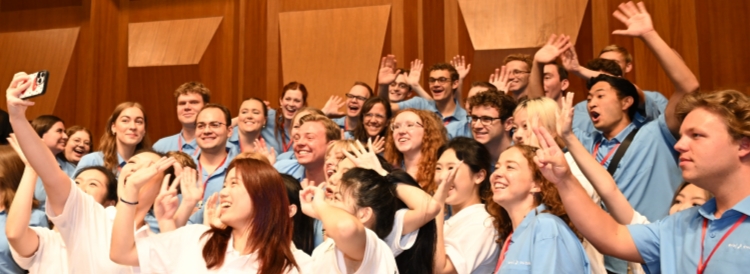

"This truly embodies the taste of spring in China," remarked participants in an international friendship-city liaison program during their visit to the Liangcuo Historic and Cultural Area in Fuzhou this September. Inside a traditional courtyard, they closely observed each step of the jasmine-tea scenting process and delighted in the freshly scented brew.

International guests give a cheerful thumbs-up while enjoying a cup of freshly scented Fuzhou jasmine tea. [Photo/fznews.com.cn]
Jasmine first arrived in China over 2,000 years ago via the Maritime Silk Road and eventually flourished in Fuzhou. By the Song Dynasty (960–1279), local artisans had developed the unique scenting technique that blends jasmine blossoms with tea leaves, giving birth to what would become Fuzhou's iconic jasmine tea. The craft thrived during the Qing Dynasty (1644–1911), when Fuzhou jasmine tea became an imperial tribute, establishing the city as a renowned "World Tea Port".
Fuzhou jasmine tea gained global attention at the 1867 Paris World Expo, where young performers from Fujian demonstrated tea arts to European audiences. These girls, aged 14 to 16 years old, were among the earliest Fujian representatives at a world expo. Around the same period, the rise of clipper ships shortened global shipping routes, further boosting the tea's international reach.
The jasmine-tea trade shaped local industries and facilitated cultural exchanges. Merchants converged in Fuzhou, foreign residents summered in Kuliang and elements of Fuzhou's culture spread abroad with its fragrant tea.
The distinctive scenting craft remains central to the enduring charm of Fuzhou jasmine tea. In 2014, the Jasmine and Tea Culture System of Fuzhou was recognized by the FAO as a Globally Important Agricultural Heritage System (GIAHS). In 2022, China's traditional tea processing techniques, of which the Fuzhou jasmine tea scenting craft was a part, were added to UNESCO's Representative List of the Intangible Cultural Heritage of Humanity.
Today, Fuzhou jasmine tea continues to attract new admirers worldwide. Under the Belt and Road Initiative, it has reached over 50 countries. For example, Fujian Chunlun Group Co has opened a branch in Paris, introducing jasmine tea to Michelin three-star restaurants and nearly 2,000 supermarkets across France. The company is further expanding in Europe through partnerships with restaurants, retailers and distributors.
At home, Fuzhou is welcoming an increasing number of international visitors eager to explore its tea heritage. The Chunlun Jasmine Tea Cultural and Creative Park, also a South-South Cooperation base, hosts up to 7,000 trainees from developing countries annually. Many come to learn about agricultural industrialization, rural vitalization and Chinese tea culture.
"Chinese tea culture is gaining global influence around," said Fu Tianlong, chairman of Chunlun Group. "We hope more international tea lovers will discover the taste of 'Chinese spring in a cup'."
